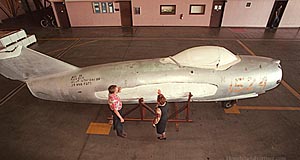 |
| John Gleeson, board member of the Aviation Museum of the Pacific, and Anne Bazzell, senior historian for Museums and Heritage Pacific Air Force, examine a Russian MiG-15 that will be built and displayed at Ford Island.
Deborah Booker • The Honolulu Advertiser |
By Karen Blakeman
Advertiser Staff Writer
The MiG-15, the first truly maneuverable fighter jet used by the Russians and their communist allies, made its worldwide debut as a war machine in Korea, flying against NATO forces and American pilots at the border between North and South Korea.
The first-generation MiG and its later incarnations became symbols of the Cold War. Until recently, none made it as far as Hawai‘i. That changed late last year, when the Hawai‘i National Guard picked one up from an Air Force "bone yard" in Arizona and flew it — carefully packed in the back of a C-130 — to Hickam Air Force Base.
The MiG-15, assembled and painted to resemble those encountered by NATO forces in Korea, will make its Hawai‘i debut in June at a Korean War Air Power Symposium being held at Hickam.
After that, a group of civilians and retired military brass hope to lay claim to it for a planned Military Aviation Museum of the Pacific, and put it on public display on Ford Island.
Historians at Hickam and backers of the aviation museum look forward to bringing together men who once faced each other at opposite ends of the MiG’s big guns.
Retired Lt. Gen. Winston W. "Bones" Marshall first encountered the MiG-15 in 1951. He was a major then, flying the F-86 Sabre jet, America’s answer to the MiG, in an area that came to be known as MiG Alley, about 200 miles north of the 38th parallel.
When Marshall arrived in Korea from his training base in the United States, he was told he would be flying against inexperienced North Koreans, with a few equally inexperienced Chinese thrown in. From nearly his first sortie, he began to suspect that description of the enemy was not accurate.
The pilot who locked on to him in one early dogfight didn’t appear to be inexperienced.
"We were wingtip to wingtip, and we both pulled back so hard we both went spinning down," Marshall said. "Then we were canopy to canopy."
The MiG had a reputation for excellent responsiveness at high altitudes, but not below 12,000 feet. Marshall, who admits fighter pilots are occasionally given to stretching the truth, swears the two planes were down to about 6,000 before he and his enemy pulled out of their spins.
Marshall said that when he regained control of his plane, the MiG was directly in his sights. He fired and the dogfight was over.
During another sortie Marshall got close enough to a flight of MiGs to get a good look at one of the pilots, who was not wearing a helmet. The man definitely was not Chinese or North Korean.
"He had red hair," Marshall said. "I went back and said, ‘We’ve got Russians flying against us out there.’ "
Marshall was told to shut up. Military and political leaders were not prepared to admit that the Cold War had become heated in Korea.
Al Miller, military historian for Headquarter Pacific Air Forces on Hickam, said both Russian and Chinese aviators, veterans of the Korean conflict, had been invited to attend the Korean War Symposium, a commemoration of the war’s 50th anniversary.
Miller said MiG-15 and F-86 pilots may stand side by side to see the newly assembled and painted MiG and an old Sabre jet.
"This will be a fighter pilot’s dream," Miller said. "Those were some legendary dog fights."
John Gleeson, one of the sponsors of the planned Military Aviation Museum of the Pacific, said, "Aviation was the element that won the war in the Pacific (theater of World War II)," Gleeson said. "It is through military aviation that we are free today."
[back to top] |

